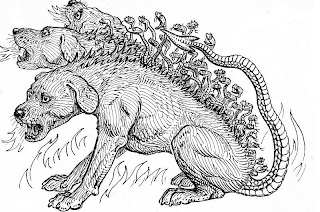 A mere 2,210 years ago the geographer Eratosthenes first measured the circumference of the Earth, using a method illustrated here. He lived near the middle of a remarkable millennium during which a number of remarkable scientific and technological achievements were made. Concrete that outlasts the usual "modern" product by a factor of 100, flammable weapons that exploded or ignited upon contact with water (including the water in an enemy's body), and the method of extracting iron from ore without actually melting it are among the achievements described by Vicki León in How to Mellify a Corpse: And Other Human Stories of Ancient Science & Superstition.
A mere 2,210 years ago the geographer Eratosthenes first measured the circumference of the Earth, using a method illustrated here. He lived near the middle of a remarkable millennium during which a number of remarkable scientific and technological achievements were made. Concrete that outlasts the usual "modern" product by a factor of 100, flammable weapons that exploded or ignited upon contact with water (including the water in an enemy's body), and the method of extracting iron from ore without actually melting it are among the achievements described by Vicki León in How to Mellify a Corpse: And Other Human Stories of Ancient Science & Superstition.The title subject is not a chapter heading in the book, but is one subject covered in one essay. Do you know the word "mellify"? Here is a useful clue: melissa means "bee". The body of Alexander was mellified, or mummified by the drying action of honey, and continued looking remarkably lifelike for centuries. It was visited by Julius and at least one other Caesar before being destroyed in a tsunami in 365 AD, 687 years after he died.
 Amidst all this scientific achievement, how were the populace affected? Only indirectly, by the improvement of infrastructure, such as the great water supply that Rome enjoyed due to its system of aqueducts. But public knowledge? Not at all.
Amidst all this scientific achievement, how were the populace affected? Only indirectly, by the improvement of infrastructure, such as the great water supply that Rome enjoyed due to its system of aqueducts. But public knowledge? Not at all.Half the essays in the book relate superstitions and myths. Many, if not most, Athenians were buried with the little coin they'd need to pay Charon to ferry them across the River Styx, and to hold back Cerberus the 3-headed dog. Many Romans, from Caesar to peasant, believed that sealskin protected one from Zeus's thunderbolts. And the ancient provisions for avoiding the Evil Eye were as numerous as methods for producing aphrodisiacs.
Lest we laugh too quickly at their superstitions, however, we ought to consider the mental habits of moderns, even in "advanced" countries. Millions still use the thumb-in-fist gesture to avert the Evil Eye if a stranger looks at them too boldly. How many find their heart beating a bit faster to pass a graveyard after dark, or if a cat crosses their path? Who still throws a pinch of spilled salt over a shoulder? The most-read column in the newspaper is the daily horoscope. Thankfully, the number who treat a seance as more serious than an evening's entertainment are few.
But if you are ever in southern Greece and see the parallel ruts in the ground, don't take the story that wagon wheels made them. They were carved there to make it easier for wagons to take the paths! Which would take a larger investment in slave labor: a pyramid in Egypt or the four-mile train track (for wagons, though, as locomotives were yet to be invented), the diolkos, across the Isthmus of Corinth?
The book is a harvest of enjoyable insights into the lives of people in six European and Near-Eastern cultures. It is made the more enjoyable by the slightly tongue-in-cheek writing style, a method that makes one confront the similarity of the ancients and ourselves. As I read, I'd find myself thinking, "I could relate to this guy," or, "Glad I never crossed paths with him!" The amount of research behind the book is only hinted at by two pages of bibliography. All in all, about 300 pages of fun reading.



No comments:
Post a Comment